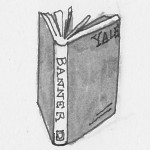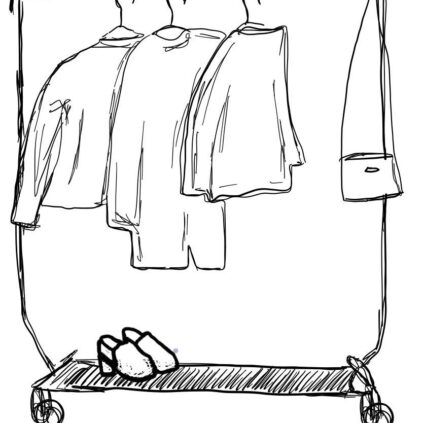
Few know the location of the office of the Banner, Yale’s yearbook. In fact, many students don’t even know that Yale has a yearbook, according to Banner senior class liason Ryan Carter ’11. So when that office was robbed the weekend of Safety Dance, the Banner’s six staff members were bewildered—first walking, then running from room to room searching for the two freshly delivered Macs (complete with Adobe CS5) that had mysteriously vanished. “It was right after we moved in,” editor-in-chief Evelyn Lopez ’11 says. “So we thought at first maybe we didn’t remember the room correctly. But no…”
The Macs were never found, but all sorts of other things can be discovered inside the Banner’s office suite, which includes a large common room full of couches (belonging not to the Banner but to Lopez), a coffee table (also Lopez’s), a wall of bookshelves stacked with Banners, empty wine bottles, empty cardboard boxes, an antiquated Schwinn bicycle, and a half-constructed desk. The darkroom next door is littered with half-empty jugs of processing chemicals and possibly valuable but definitely unusable photo equipment. There’s a future office space in which each Banner member has tagged the desk where he or she hopes to sit one day, a computer room with replacement Macs, and an oversized storage closet lined almost floor-to-ceiling with boxes. Each weighs at least 60 pounds and contains hundreds of leftover and undelivered yearbooks, as well as abandoned copies of Old Campus, the yearbook for the freshman class.
The boxes used to cover the floor of the common room. As soon as Lopez moved in, she organized cleaning and moving days, during which Banner staff moved each and every box into storage. Lopez’s tenure marks the second year that students have led the yearbook’s production, which was taken over in 1995 by the Association of Yale Alumni after former Banner staff took out a loan of $150,000 for equipment, which the publication was unable to repay. The loan is still outstanding. When Lopez met last year’s Banner editors after an information session last spring, she told them, “Look, I’m not going to lie, I want to be editor-in-chief.” They agreed, and left their boxes for her.
Tidying up the office might seem like an odd priority for an organization that struggles with lack of interest, lack of involvement, and lack of funding. In recent years, however, the office was so neglected that an unidentified man once moved in after the spring term ended. He slept on a futon in the desk-room; he also had several boxes full of possessions that he tagged with his name. Lopez threw all of these items away (well, except the futon, which the staff still uses). At the time, it seems, the squatter didn’t matter—either because no one used the office or because no one cared. Now, the editors are so concerned with office orderliness because they see the rundown Banner offices as a barrier to fulfilling the promise of The Yale Banner, the country’s oldest college yearbook. They are remodeling in order to reinvigorate and resurrect.
“Resurrection” has become the keyword for the 2011 Banner: new birth, new beginnings, new year, new yearbook. This might be a necessary strategy given that, despite 169 years of history, as Carter put it, “people don’t know Yale has a yearbook.”
That Yale students would not know or care to know about their school’s own yearbook mystifies Eddie Breaux, proprietor of a bed and breakfast called McKendrick-Breaux House in New Orleans, Louisiana, and one of the foremost amateur collectors of yearbooks. He owns many copies of the Banner and several rare specialty items of memorabilia, such as a Yale autograph book hand-made in the 1850s for students to collect each other’s signatures. His enthusiasm for the Banner (and yearbooks in general) is enormous. He will probably not buy the 2011 yearbook, though—he is less interested in modern designs.
Maybe someday, a future collector with an interest in arcane class data, quotes, and photos of students from 2011 posing against a speckled blue background may want to buy a copy.
And someday, the editors hope, a new generation will care. In the cleaning process, they have found that others once did. Lopez and her staff unearthed mementos of past editors, including several oblong concrete blocks with names and nicknames painted on them—clearly part of an inside joke. Now, the Banner staff is on the outside. Lopez points to them, saying, “See, there used to be a culture here. These meant something, but I have no idea what, so I’m throwing them out. We’re starting over.”
Starting over means an eager but novice staff. Lopez, who has never edited a yearbook before, asserts, “We learn by doing here.” They are learning, they say, to get seniors to show up for yearbook photos, to fill out questionnaires, to offer candid photos. They are learning to do layout and design, to interact as coworkers, and to deal with difficult customers: a senior who insists on using her own glamour shot instead of a professionally taken photo, a mother who calls Lopez to find out if her son sat for his yearbook photo instead of calling the suspect himself.
The staff jokes and exchanges Secret Santa gifts, creating new traditions to take the place of the mysterious blocks. The Banner has a culture again, and they’ve tried their best to make it different from that of the past 168 years. But despite clearing out the old boxes and shelving thousands of tomes, it’s clear that history still weighs on them. When they get serious, they say they “can’t let the oldest college yearbook in the nation die.”
And if they get their way, the Banner won’t. The class of 2011 will buy their books at $100 each and keep them forever—or at least sell them to appreciative collectors some years down the road.


